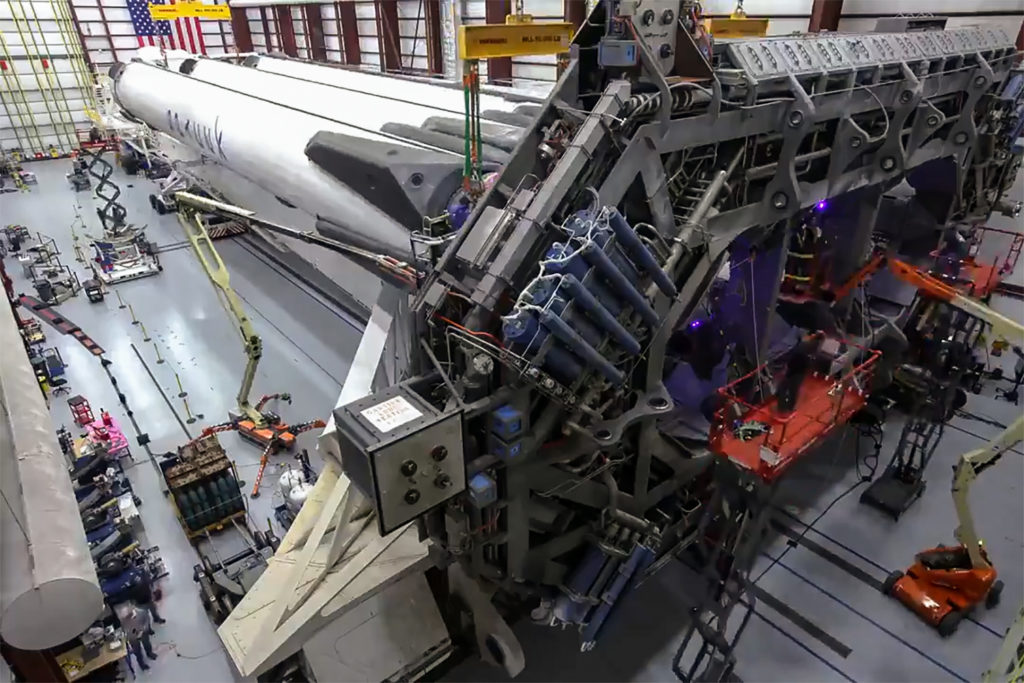News
LaunchPad: Falcon Heavy ready to go for commercial launch debut
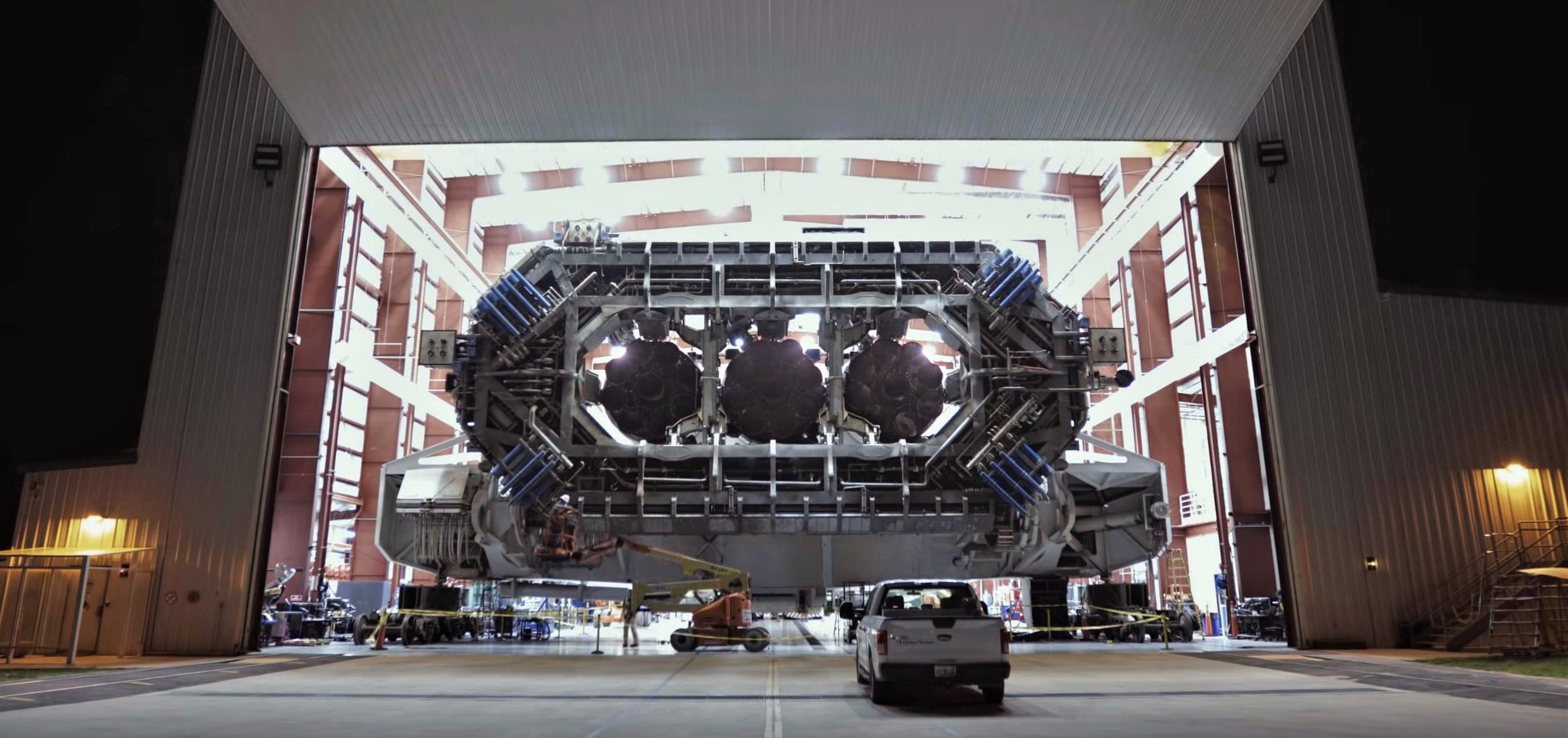
This is a free preview of LaunchPad, one of Teslarati’s member-only launch briefing newsletters. Before each SpaceX launch, I’ll give you an inside look of what to expect and share amazing photos and on-the-ground details after the launch. Become a member today receive all of Teslarati’s newsletters.
SpaceX launch technicians and engineers have officially completed the integration and static fire testing of the second Falcon Heavy rocket ever, nearing the end of preflight preparations for the vehicle’s critical commercial launch debut.
Carrying the commercial communications satellite Arabsat 6A, the rocket will be tasked with placing the massive spacecraft into a high-energy geostationary orbit. After a combination of hurdles and conflicting priorities conspired to delay Arabsat 6A’s launch from mid-2018 to February, March, and eventually, April of 2019, both the spacecraft and rocket are nearly ready to go. If all goes as planned, SpaceX will also complete the first successful launch and near-simultaneous landings of three independent rocket boosters, preparing two of the three boosters for reuse on a launch that could happen as early as June 2019.
When: 6:35 pm EDT, 22:35 UTC (click for your time), April 10th
What: Arabsat 6A, communications satellite, ~6000 kg (13,200 lb)
Where: Pad 39A, Kennedy Space Center, Florida
Boosters: B1052.1, B1053.1, B1055.1
Recovery: Yes; drone ship Of Course I Still Love You (OCISLY) & LZ-1/2
Weather: 80% GO, 4/10

Falcon 9 Block 5, meet Falcon Heavy
- With this Falcon Heavy, SpaceX has effectively built – once again – a center stage that is nearly its own rocket, much like the tortured development of the first vehicle’s center stage can be blamed for a lot of its years of delays.
- Based on Falcon 9 V1.2’s Block 3 iteration, Falcon Heavy Flight 1’s center core was effectively outdated a year before it launched, and Falcon 9 Block 5 debuted just three months after its first and last launch.
- Combined with the center core’s untimely demise when it crashed into the Atlantic after running out of engine starter, the now 14 months separating Flight 1 and Flight 2 of Falcon Heavy can be explained by the rocket’s delayed path to the launch site.
- By the time the first Falcon Heavy’s main components were all present in at the launch site, SpaceX was already building Block 5 rockets and was as few as three months away from completely transitioning its Hawthorne, CA factory to Block 5.
- Due to the extensive changes in production incorporated into Block 5, this was effectively a no-turning-back deal where the cost of transitioning back was simply a non-starter.
- By the time Falcon Heavy had launched, and its center core had smashed itself to pieces on the Atlantic Ocean surface, it was far too late to begin producing a replacement copy. One step further, the process of ramping up Block 5 production had been slowed significantly by the drastic changes made across the board, taking SpaceX to the edge of production-related launch delays over the course of 2018.
- Put simply, building two side boosters and a relatively boutique Falcon Heavy center core – all three of which would be inextricably tied together for the foreseeable future – was not a practical option when three separate Falcon 9 Block 5 boosters could instead support 6-12+ launches over a period of six or so months.
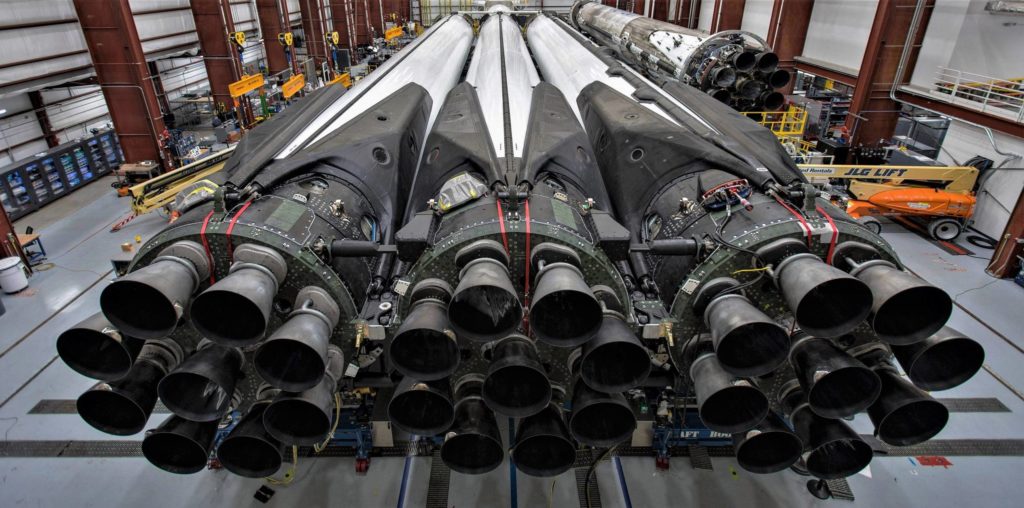
(Hopefully) the first of many
- In the nominal event that SpaceX’s second Falcon Heavy launch is an unqualified success, it’s entirely possible that the doors to new markets could be opened as the world and its many spacefaring customers begin to contemplate the existence of an affordable super-heavy-lift launch vehicle – the first of its kind.
- On the outside, Falcon Heavy can begin to look like a bit of a boondoggle from a business perspective. It will have probably cost no less than $750M-$1B to develop, including the Block 5 modifications needed, and likely brought in less than $100M in gross revenue. It’s a black hole that SpaceX currently dumps huge volumes of cash into, in other words.
- However, this sort of observation is far too pessimistic and gives SpaceX far too little credit after some additional careful analysis. As of today, SpaceX has six public launch contracts for FH, two of which are from the USAF/NRO and likely valued around $130M-$150M.
- Purely commercial contracts for Falcon Heavy will probably be closer to $90M-100M, more than competitive with rockets like Atlas 5, Delta IV Heavy, Ariane 5, and other future vehicles like ULA’s Vulcan.
- Within ~12 months, the USAF will likely have awarded 10-16 additional launch contracts to some combo of Falcon 9 and Falcon Heavy as part of the latest EELV (now NSSL) acquisition phase. Assuming SpaceX is one of the two providers chosen, Falcon Heavy could receive numerous additional contracts for heavy military satellites.
- Additionally, NASA is now seriously considering Falcon Heavy for the launch of flagship missions like Europa Clipper and (maybe, maybe not) even Orion missions to the Moon.
- Falcon Heavy could also be the only vehicle in the world with the performance needed for a number of other missions that could arise from the Lunar Gateway, including launching actual segments of the space station and launching deep space cargo missions resupply said Gateway.
- Only ULA’s Delta IV Heavy can marginally compete with Falcon Heavy’s performance, but it typically costs no less than $300M per launch, a 2-3X surcharge over SpaceX’s offering. Due to the utter and complete lack of competition from both a price and performance perspective, SpaceX could essentially have the heavy life market cornered for something like 48-60+ months.
- Offering a unique product with potentially high demand and no real alternative, SpaceX would not be out of place to raise its profit margins significantly, helping to rapidly pay back the capital investment it put into Falcon Heavy’s extended development.
- Regardless, the future of Falcon Heavy has every right to be even more thrilling and diverse than the already impressive Falcon 9.



You can watch Falcon Heavy’s commercial launch debut live here on April 10th at 6:35 pm EDT (22:35 UTC). We’ll see you after the launch at LandingZone with exclusive photos and on-the-ground details of Falcon Heavy’s center core recovery.
News
Tesla UK sales see 14% year-over-year rebound in June: SMMT data
The SMMT stated that Tesla sales grew 14% year-over-year to 7,719 units in June 2025.
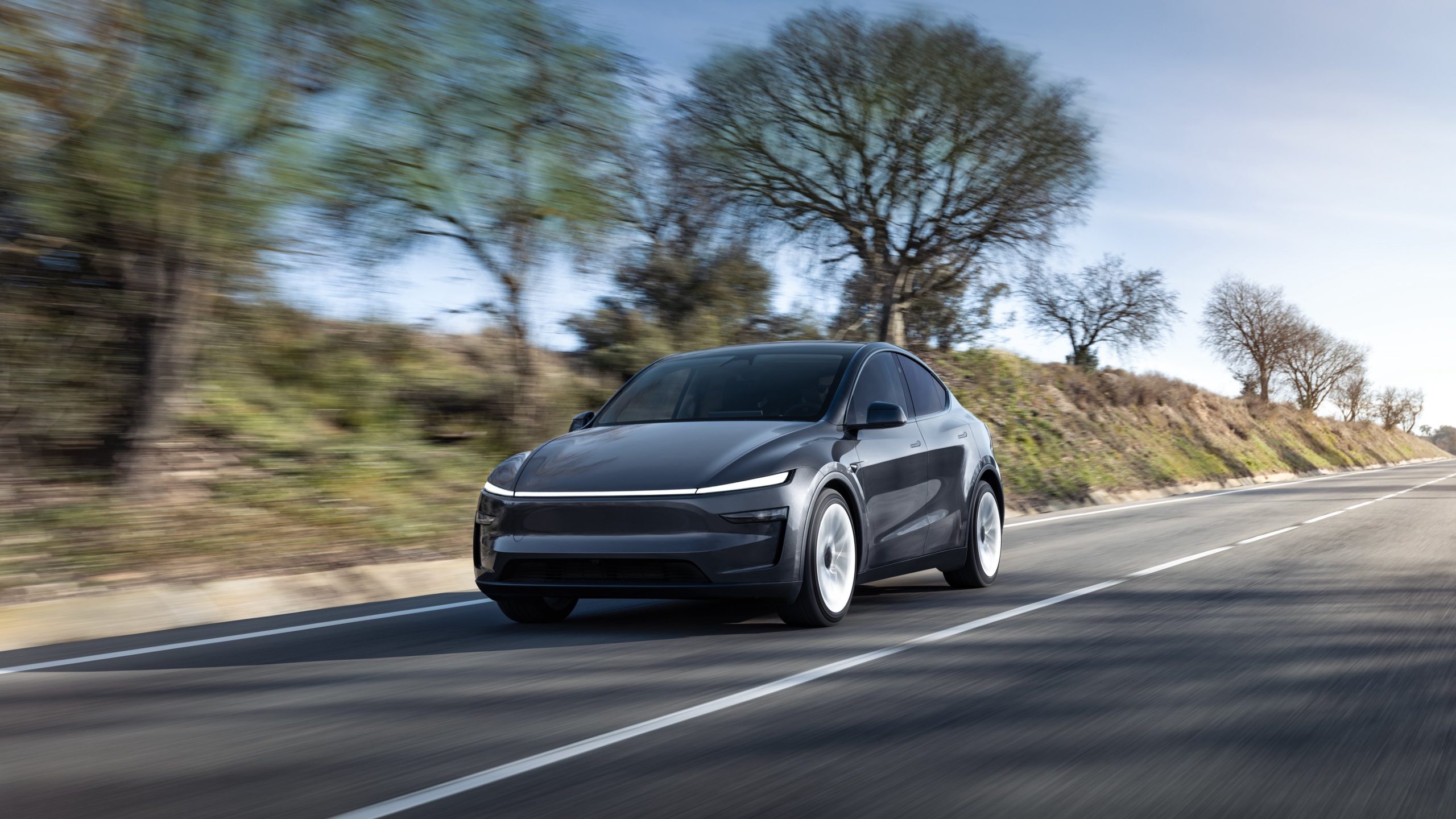
Tesla’s sales in the United Kingdom rose in June, climbing 14% year-over-year to 7,719 units, as per data from the Society of Motor Manufacturers and Traders (SMMT). The spike in the company’s sales coincided with the first deliveries of the updated Model Y last month.
Model Y deliveries support Tesla’s UK recovery
Tesla’s June performance marked one of its strongest months in the UK so far this year, with new Model Y deliveries contributing significantly to the company’s momentum.
While the SMMT listed Tesla with 7,719 deliveries in June, independent data from New AutoMotive suggested that the electric vehicle maker registered 7,891 units during the month instead. However, year-to-date figures for Tesla remain 2% down compared to 2024, as per a report from Reuters.
While Tesla made a strong showing in June, rivals are also growing. Chinese automaker BYD saw UK sales rise nearly fourfold to 2,498 units, while Ford posted the highest EV growth among major automakers, with a more than fourfold increase in the first half of 2025.
Overall, the UK’s battery electric vehicle (BEV) demand surged 39% to to 47,354 units last month, helping push total new car sales in the UK to 191,316 units, up 6.7% from the same period in 2024.
EV adoption accelerates, but concerns linger
June marked the best month for UK car sales since 2019, though the SMMT cautioned that growth in the electric vehicle sector remains heavily dependent on discounting and support programs. Still, one in four new vehicle buyers in June chose a battery electric vehicle.
SMMT Chief Executive Mike Hawes noted that despite strong BEV demand, sales levels are still below regulatory targets. “Further growth in sales, and the sector will rely on increased and improved charging facilities to boost mainstream electric vehicle adoption,” Hawes stated.
Also taking effect this week was a new US-UK trade deal, which lowers tariffs on UK car exports to the United States from 27.5% to 10%. The agreement could benefit UK-based EV producers aiming to expand across the country.
News
Tesla Model 3 ranks as the safest new car in Europe for 2025, per Euro NCAP tests
Despite being on the market longer than many of its rivals, the Tesla Model 3 continues to set the bar for vehicle safety.

The Tesla Model 3 has been named the safest new car on sale in 2025, according to the latest results from the Euro NCAP. Among 20 newly tested vehicles, the Model 3 emerged at the top of the list, scoring an impressive 359 out of 400 possible points across all major safety categories.
Tesla Model 3’s safety systems
Despite being on the market longer than many of its rivals, the Tesla Model 3 continues to set the bar for vehicle safety. Under Euro NCAP’s stricter 2025 testing protocols, the electric sedan earned 90% for adult occupant protection, 93% for child occupant protection, 89% for pedestrian protection, and 87% for its Safety Assist systems.
The updated Model 3 received particular praise for its advanced driver assistance features, including Tesla’s autonomous emergency braking (AEB) system, which performed well across various test scenarios. Its Intelligent Speed Assistance and child presence detection system were cited as noteworthy features as well, as per a WhatCar report.
Other notable safety features include the Model 3’s pedestrian-friendly pop-up hood and robust crash protection for both front and side collisions. Euro NCAP also highlighted the Model 3’s ability to detect vulnerable road users during complex maneuvers, such as turning across oncoming traffic.
Euro NCAP’s Autopilot caution
While the Model 3’s safety scores were impressive across the board, Euro NCAP did raise concerns about driver expectations of Tesla’s Autopilot system. The organization warned that some owners may overestimate the system’s capabilities, potentially leading to misuse or inattention behind the wheel. Even so, the Model 3 remained the highest-scoring vehicle tested under Euro NCAP’s updated criteria this year.
The Euro NCAP’s concerns are also quite interesting because Tesla’s Full Self-Driving (FSD) Supervised, which is arguably the company’s most robust safety suite, is not allowed for public rollout in Europe yet. FSD Supervised would allow the Model 3 to navigate inner city streets with only minimal human supervision.
Other top scorers included the Volkswagen ID.7, Polestar 3, and Geely EX5, but none matched the Model 3’s total score or consistency across categories. A total of 14 out of 20 newly tested cars earned five stars, while several models, including the Kia EV3, MG ZS, and Renault 5, fell short of the top rating.
Elon Musk
Why Tesla’s Q3 could be one of its biggest quarters in history
Tesla could stand to benefit from the removal of the $7,500 EV tax credit at the end of Q3.

Tesla has gotten off to a slow start in 2025, as the first half of the year has not been one to remember from a delivery perspective.
However, Q3 could end up being one of the best the company has had in history, with the United States potentially being a major contributor to what might reverse a slow start to the year.
Earlier today, the United States’ House of Representatives officially passed President Trump’s “Big Beautiful Bill,” after it made its way through the Senate earlier this week. The bill will head to President Trump, as he looks to sign it before his July 4 deadline.
The Bill will effectively bring closure to the $7,500 EV tax credit, which will end on September 30, 2025. This means, over the next three months in the United States, those who are looking to buy an EV will have their last chance to take advantage of the credit. EVs will then be, for most people, $7,500 more expensive, in essence.
The tax credit is available to any single filer who makes under $150,000 per year, $225,000 a year to a head of household, and $300,000 to couples filing jointly.
Ending the tax credit was expected with the Trump administration, as his policies have leaned significantly toward reliance on fossil fuels, ending what he calls an “EV mandate.” He has used this phrase several times in disagreements with Tesla CEO Elon Musk.
Nevertheless, those who have been on the fence about buying a Tesla, or any EV, for that matter, will have some decisions to make in the next three months. While all companies will stand to benefit from this time crunch, Tesla could be the true winner because of its sheer volume.
If things are done correctly, meaning if Tesla can also offer incentives like 0% APR, special pricing on leasing or financing, or other advantages (like free Red, White, and Blue for a short period of time in celebration of Independence Day), it could see some real volume in sales this quarter.
You can now buy a Tesla in Red, White, and Blue for free until July 14 https://t.co/iAwhaRFOH0
— TESLARATI (@Teslarati) July 3, 2025
Tesla is just a shade under 721,000 deliveries for the year, so it’s on pace for roughly 1.4 million for 2025. This would be a decrease from the 1.8 million cars it delivered in each of the last two years. Traditionally, the second half of the year has produced Tesla’s strongest quarters. Its top three quarters in terms of deliveries are Q4 2024 with 495,570 vehicles, Q4 2023 with 484,507 vehicles, and Q3 2024 with 462,890 vehicles.
-

 Elon Musk4 days ago
Elon Musk4 days agoTesla investors will be shocked by Jim Cramer’s latest assessment
-

 News1 week ago
News1 week agoTesla Robotaxi’s biggest challenge seems to be this one thing
-

 Elon Musk2 weeks ago
Elon Musk2 weeks agoFirst Look at Tesla’s Robotaxi App: features, design, and more
-

 News2 weeks ago
News2 weeks agoSpaceX and Elon Musk share insights on Starship Ship 36’s RUD
-

 News2 weeks ago
News2 weeks agoWatch Tesla’s first driverless public Robotaxi rides in Texas
-

 News1 week ago
News1 week agoWatch the first true Tesla Robotaxi intervention by safety monitor
-

 News2 weeks ago
News2 weeks agoTesla has started rolling out initial round of Robotaxi invites
-
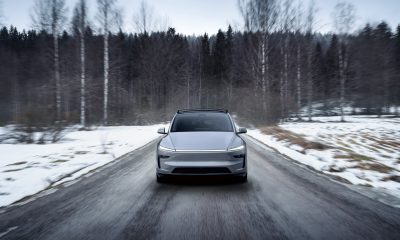
 Elon Musk2 weeks ago
Elon Musk2 weeks agoTesla to launch in India in July with vehicles already arriving: report

